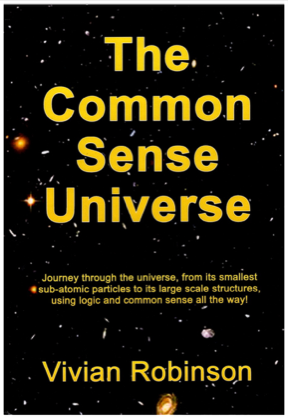
The science, technology and engineering for this project was researched, developed and designed by Dr Vivian Robinson. His career background was quite different from the average PhD physicist. So too are some of his achievements.
He was the first physicist/mathematician to work out the physics that underpins Einstein's relativity theories. Einstein's gravity theory, from his general relativity paper, was generally seen as the most complex topic. In his paper:
"Physical explanation of Einstein's gravity"
Dr Robinson reduced the complexity of Einstein's gravity field equations from:
The Robinson detector was the world's first high efficiency backscattered electron (BSE) detector. It enabled a whole lot more information to be seen in scanning electron microscopes (SEMs). That was combined with a technique that enabled uncoated insulators and specimens containing water and other liquids to be viewed in the vacuum systems of SEMs. It gave the ease of specimen preparation of an optical microscope with the resolution and depth of focus of SEMs. Between the two, they revolutionized the way SEMs were used. Some SEM manufacturers indicated their sales increased by 25% because of those developments. Examples of some images, not possible before Dr Robinson's developments, are given below. These were all images that "experts" said could never be taken or were of no interest to anyone.
The above shows that Dr Robinson combines world leading mathematics and physics capabilities with good engineering skills and commercial reality. He calls them "using common sense". That background is rare among physicists. It is what is needed for complex projects like developing nuclear fusion reactors.
Understanding the physics and simplifying the maths of Einstein's gravity and relativity theories has eluded "the best" in those fields. That puts his physics and maths skills up there with the best.
His work on gravity was not done in isolation. He was awarded his PHD in physics in 1970. He worked in academia until 1984. During that time he developed equipment and processes world experts said would never work or were of no use. He left academia to exploit his developments.
Details of aspects of his commercial work are given after this section.
Throughout his commercial years, he never lost his interest in the basics of science. Not liking the explanations given by "experts", he evaluated the universe from a common sense perspective. His successful commercial career lasted over three decades. With sufficient earnings to fund his own research, he resumed his study of the the universe, from its smallest sub-atomic particles to its large scale structure. During that study he contacted Dr John Williamson and Quicycle.
He compiled his extensive study into a book he called "The Common Sense Universe". Its complexities, from its smallest sub-atomic particles to its large scale structure are shown to have logical explanations. The topics covered are listed by chapters below the book cover. show his study went continuously from the smallest structures of the universe to its large scale structure.
There are those who try to pretend the topics covered are too complex for mere mortals to understand. They aren't complex.
That unnecessary complexity also hindering the development of:
Controlled Nuclear Fusion Power?

Ch 1 Space and Photons
Ch 2 Photons to Particles
Ch 3 Real Particles
Ch 4 Elementary Particles
Ch 5 Nuclear Binding and the
Structure of Nuclei
Ch 6 The Abundance of Nuclei
Ch 7 Electrons in Atoms
Ch 8 Einstein's gravity
Ch 9 The Physical Origins of Gravity
Ch 10 Some Galaxy Properties
Ch 11 Mechanics of the Universe
Ch 12 Describing the Universe

to

Throughout the book, his approach was to describe the physics and then use mathematics to show the magnitude of the effect. Information published in the book matches observation better than the existing paradigms.
Beyond chapter 1, it is not "standard model" and "accepted general relativity" paradigm. From this fusion study point of view, the important features are chapters 5 and 6. Chapter 5 answers lots of questions that nuclear physicists want to know that aren't explained in the standard model paradigm.
Developing a new theory is not of much use if it does not have practical uses. The greatest practical application is in nuclear physics in general, with fusion the greatest prize.
Those interested in reproducing the sun's fusion process would benefit enormously from chapter 6. Those two chapters laid the foundations for this quantum fusion process.
Copies of The Common Sense Universe can be obtained from:

An efficient backscattered electron detector, a product "world experts" said would never work.
➙
Aspects of Commercial Career

Uncoated insulators
Wool fibre in liquid water
Hydrated insect leg
Pollen grains on flower
Details are given in
VN E Robinson 2021 J. Phys. Commun. 5 035013
About Developer

